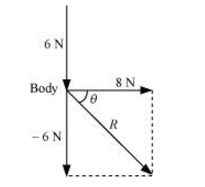A body of mass 0.40 kg moving initially with a constant speed of 10 m s–1 to the north is subject to a constant force of 8.0 N directed towards the south for 30 s. Take the instant the force is applied to be t = 0, the position of the body at that time to be x = 0, and predict its position at t = –5 s, 25 s, 100 s.
Given,
Mass of the body, m = 0.40 kg
Initial speed of the body, u = 10 m/s, due north
Force acting on the body, F = –8.0 N
Acceleration produced in the body, a =  (i)
(i)
At t = –5 s,
Acceleration, a' = 0
Initial velocity, u = 10 m/s
Using the relation,
s = ut + (1/2) a' t2
= 10 × (–5) = –50 m(ii)
At t = 25 s
Acceleration, a'' = –20 m/s2
Initial velocity, u = 10 m/s
USing the relation,
s' = ut' + (1/2) a" t2
= 10 × 25 + (1/2) × (-20) × (25)2
= 250 - 6250
= -6000 m(iii)
At t = 100 s,
For 0 ≤ t ≤ 30 s
Acceleration, a = -20 ms-2
Initial velocity, u = 10 m/s
Now, using the equation of motion, we have
s1 = ut + (1/2)a"t2
= 10 × 30 + (1/2) × (-20) × (30)2
= 300 - 9000
= -8700 m
For 30 < t ≤ 100 s,For t= 30 sec, as per the first equation of motion final velocity is given as,
v = u + at
= 10 + (–20) × 30
= –590 m/s
Velocity of the body after 30 s = –590 m/s
For motion between 30 s to 100 s, i.e., in 70 s:
s2 = vt +  a" t2
a" t2
= -590 × 70
= -41300 m
∴ Total distance, s" = s1 + s2
= -8700 -41300
= -50000 m
= -50 km.



![]()
![]() is the angle made by R with the force of 8 N.
is the angle made by R with the force of 8 N.![]()
![]()



 a" t2
a" t2 